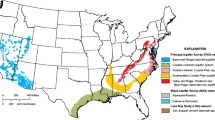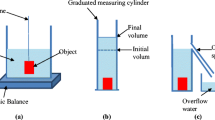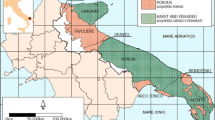Abstract
Samples of groundwater and the enclosing sediments were compared for densities of bacteria using direct (acridine orange direct staining) and viable (growth on 1% PTYG medium) count methodology. Sediments to a depth of 550 m were collected from boreholes at three sites on the Savannah River Site near Aiken, South Carolina, using techniques to insure a minimum of surface contamination. Clusters of wells screened at discreet intervals were established at each site. Bacterial densities in sediment were higher, by both direct and viable count, than in groundwater samples. Differences between direct and viable counts were much greater for groundwater samples than for sediment samples. Densities of bacteria in sediment ranged from less than 1.00×106 bacteria/g dry weight (gdw) up to 5.01 ×108 bacteria/gdw for direct counts, while viable counts were less than 1.00×103 CFU/gdw to 4.07×107 CFU/gdw. Bacteria densities in groundwater were 1.00×103–6.31×104 bacteria/ml and 5.75–4.57×102 CFU/ml for direct and viable counts, respectively. Isolates from sediment were also found to assimilate a wider variety of carbon compounds than groundwater bacteria. The data suggest that oligotrophic aquifer sediments have unique and dense bacterial communities that are attached and not reflected in groundwater found in the strata. Effective in situ bioremediation of contaimination in these aquifers may require sampling and characterization of sediment communities.
Similar content being viewed by others
References
Balkwill DL (1989) Numbers, diversity, and morphological characteristics of aerobic, chemoheterotrophic bacteria in deep subsurface sediments from a site in South Carolina. Geomicrobiol J 7:33–52
Balkwill DL, Ghiorse WC (1985) Characterization of subsurface bacteria associated with two shallow aquifers in Oklahoma. Appl Environ Microbiol 50:580–588
Balkwill DL, Fredrickson JK, Thomas JM (1989) Vertical and horizontal variations in the physiological diversity of the aerobic chemoheterotrophic bacterial microflora in deep southeast coastal plain subsurface sediments. Appl Environ Microbiol 55:1058–1065
Bartha R, Bossert I (1984) The treatment and disposal of petroleum wastes. In: Atlas R (ed) Petroleum microbiology. Macmillan, New York, pp 553–577
Bone TL, Balkwill DL (1988) Morphological and cultural comparison of microorganisms in surface soil and subsurface sediments at a pristine study site in Oklahoma. Microb Ecol 16: 49–64
Brockman FJ, Donovan BA, Hicks RJ Fredrickson JK (1989) Isolation and characterization of quinoline-degrading bacteria from subsurface sediments. Appl Environ Microbiol 55:1029–1032
Craun GF (1986) Waterborne diseases in the United States. CRC Press, Boca Raton, FL
Fliermans CB (1989) Microbial life in the terrestrial subsurface of southeastern coastal plain sediments. Haz Was Haz Mat 6:155–171
Fliermans CB, Balkwill DL (1989) Microbial life in deep terrestrial subsurfaces. BioScience 39:370–377
Fliermans CB, Phelps TJ, Ringelberg D, Mikell AT, White DC (1988) Mineralization of trichloroethylene by heterotrophic enrichment cultures. Appl Environ Microbiol 54:1709–1714
Fredrickson JK, Garland TR, Hicks RJ, Thomas JM, Li SW, McFadden KM (1989) Lithotrophic and heterotrophic bacteria in deep subsurface sediments and their relation to sediment properties. Geomicrobiol J 7:53–66
Fredrickson JK, Hicks RJ, Li SW Brockman FJ (1988) Plasmid incidence in bacteria from deep subsurface sediments. Appl Environ Microbiol 54:2916–2923
Ghiorse WC, Wilson JT (1988) Microbial ecology of the terrestrial subsurface. Adv Appl Microbiol 33:107–172
Harvey RW, George LH (1987) Growth determination for unattached bacteria in a contaminated aquifer. Appl Environ Microbiol 53:2992–2996
Harvey RW, Smith RL, George LH (1984) Effect of organic contamination upon microbial distributions and heterotrophic uptake in a Cape Cod, Mass., aquifer. Appl Environ Microbiol 48:1197–1202
Hicks RJ, Fredrickson JM (1989) Aerobic metabolic metabolic potential of microbial populations indigenous to deep subsurface environments. Geomicrobiol J 7: 67–77
Hobbie JE, Daley RJ, Jasper S (1977) Use of Nuclepore filters for counting bacteria by fluorescence microscopy. Appl Environ Microbiol 33: 1225–1228
Jannasch HW, Jones GE (1959) Bacterial populations in sea water as determined by different methods of enumeration. Limnol Oceanogr 4: 128–139
Jiménez L (1990) DNA comparison of deep terrestrial subsurface bacteria isolated from different geological and hydrological strata. Appl Environ Microbiol 56: 2108–2113
Kölbel-Boelke J, Tienken B, Nehrkorn A (1988) Microbial communities in the saturated groundwater environment. I. Methods of isolation and characterization of heterotrophic bacteria. Microb Ecol 16: 17–29
Kölbel-Boelke J, Anders E, Nehrkorn A (1988) Microbial communities in the saturated groundwater environment. II. Diversity of bacterial communities in a Pleistocene sand aquifer and their in vitro activities. Microb Ecol 16: 31–48
López-Torres AJ, Prieto L, Hazen TC (1988) Comparison of the in situ survival and activity ofKlebsiella pneumoniae andEscherichia coli in tropical marine environments. Microb Ecol 15: 41–57
Patrick R, Ford E, Luarles J (1983) Groundwater contamination in the United States, 2nd ed. University of Pennsylvania Press, Philadelphia, PA
Phelps TJ, Fliermans CB, Garland TR, Phiffner SM, White DC (1989) Methods for recovery of deep terrestrial subsurface sediments for microbiological studies. J Microbiol Meth 9: 267–280
Poindexter J (1981) Oligotrophy: Fast and famine existence. Adv Microb Ecol 5: 63–90
Roszak DB, Colwell RR (1987) Survival strategies of bacteria in the natural environment. Microbiol Rev 51: 365–379
Sargent KA, Fliermans CB (1989) Geology and hydrology of the deep subsurface microbiology sampling sites at the Savannah River Plant, South Carolina. Geomicrobiol J 7: 3–14
Sinclair JL, Ghiorse WC (1989) Distribution of aerobic bacteria, protozoa, algae, and fungi in deep subsurface sediments. Geomicrobiol J 7: 15–32
Tunlid A, Ringelberg D, Phelps TJ, Low C, White DC (1989) Measurement of phospholipid fatty acids at picomolar concentrations in biofilms and deep subsurface sediments using gas chromatography and chemical ionization mass spectrometry. J Microbiol Meth 10: 139–153
Upton AC, Nedwell DB (1989) Nutritional flexibility of oligotrophic and copiotrophic Antarctica bacteria with respect to organic substrates. FEMS Microb Ecol 62: 1–6
Zar JH (1984) Biostatistical analysis, 2nd ed. Prentice-Hall, Englewood Cliffs, NJ
Author information
Authors and Affiliations
Rights and permissions
About this article
Cite this article
Hazen, T.C., Jiménez, L., López de Victoria, G. et al. Comparison of bacteria from deep subsurface sediment and adjacent groundwater. Microb Ecol 22, 293–304 (1991). https://doi.org/10.1007/BF02540231
Received:
Revised:
Issue Date:
DOI: https://doi.org/10.1007/BF02540231




